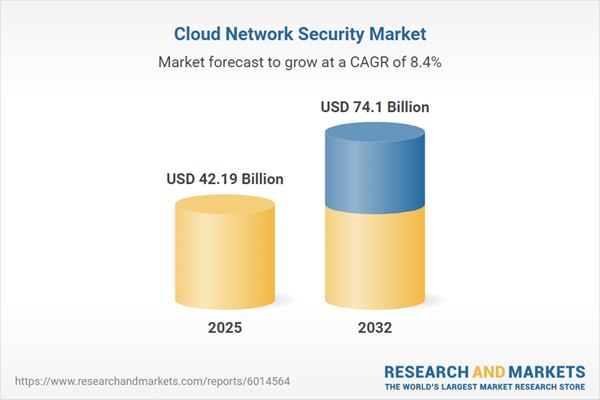Speak directly to the analyst to clarify any post sales queries you may have.
Cloud network security is essential for organizations navigating diverse infrastructures and cross-border operations, providing flexible protection and agility as the threat landscape and compliance obligations evolve.
Cloud Network Security Market Snapshot
The cloud network security market is set for substantial growth, with value expected to increase from USD 38.96 billion in 2024 to USD 42.19 billion by 2025, and further to USD 74.10 billion by 2032. This expansion is supported by the adoption of hybrid and multi-cloud environments, increased digital transformation across sectors, and escalating cyber threat complexity. Organizations are elevating layered security measures to achieve stronger visibility, governance, and threat detection. Shifts in regulatory frameworks are encouraging improvements in operational assurance and compliance. As more businesses migrate to cloud-native models, the demand for scalable, adaptable network security solutions continues to rise, emphasizing the importance of robust protection tailored to modern enterprise needs.
Scope & Segmentation: Cloud Network Security Market
This report provides actionable analysis for leaders aiming to align security and technology strategies with the latest market dynamics. The segmentation framework enables senior decision-makers to identify optimal procurement and compliance pathways across key business areas:
- Component: Includes Distributed Denial of Service Protection, Firewall as a Service, Intrusion Prevention System, Microsegmentation, Virtual Private Network, Web Application Firewall, and Zero Trust Network Access—each targeting essential access control and multi-layered protection needs.
- Deployment Model: Covers Hybrid Cloud, Multi-Cloud, Private Cloud, and Public Cloud. Each option impacts data governance, integration, and capacity planning requirements.
- Service Model: Infrastructure as a Service (IaaS), Platform as a Service (PaaS), and Software as a Service (SaaS) enable flexible security architectures and affect regulatory approaches across business functions.
- Organization Size: Solutions tailored to both Large Enterprises and Small/Medium Enterprises reflect different governance practices and compliance resources.
- Industry Vertical: Banking & Financial Services, Government & Defense, Healthcare & Life Sciences, IT & Telecom, Manufacturing, and Retail & E-Commerce, each requiring unique strategies for regulatory alignment and data protection.
- Distribution Channel: Access to Channel Partners and Direct sales offers organizations the flexibility to structure procurement and partnerships to match evolving needs.
- Region: The Americas, Europe, Middle East & Africa, and Asia-Pacific are all covered, considering distinct adoption drivers and data residency challenges in each geography.
- Leading Providers: Key vendors include Palo Alto Networks, Cisco Systems, Fortinet, Check Point Software Technologies, Zscaler, Juniper Networks, Trend Micro, Cloudflare, F5, and Netskope, each shaping technology standards and integration priorities.
The segmentation framework equips enterprises to realign security investments with business objectives and adapt to region-specific compliance, technology, and operational developments. Strategic alignment in areas such as microsegmentation and zero trust network access supports deployment flexibility for expanding and highly regulated organizations.
Key Takeaways for Senior Decision-Makers
- Cloud-native frameworks help standardize protection across legacy and emerging platforms, ensuring consistent enforcement of security policies in increasingly distributed environments.
- Zero trust architecture and microsegmentation offer greater control of access and minimize lateral threat movement, which enhances vendor engagement flexibility and streamlines policy management.
- Advanced analytics and adaptive enforcement empower organizations to accelerate threat detection, automate response, and reduce exposure across complex cloud operations.
- Organizations in regulated sectors are customizing security strategies to reinforce data sovereignty, aligning with industry-specific compliance directives and protecting sensitive workloads.
- The expansion of edge computing and dynamic compliance needs increases the importance of tools that operate seamlessly together, supporting reliable business continuity and a resilient security posture.
- Procurement via both direct and channel-based models helps enterprises align security spending with internal governance structures and achieve tailored operational outcomes.
Tariff Impact and Supply Chain Shifts
The introduction of new US tariffs in 2025 is prompting providers to diversify their supply chains and focus on software-based security models. Enterprises are prioritizing adaptable, regionally sourced solutions that limit reliance on hardware, thereby boosting resilience to trade and regulatory disruptions.
Methodology & Data Sources
The analysis in this report is grounded in direct interviews with CISOs, cloud security architects, and technical managers, complemented by examination of network traffic and current deployment trends. Extensive secondary research and input from industry workshops ensure that all findings are relevant and actionable for today’s security leaders.
Why This Report Matters
- Helps executive teams update security strategies in line with shifting regulatory climates and operational requirements.
- Offers benchmarks and recommendations to support optimized procurement and governance at global scale.
- Enables fact-based decision-making through periods of regulatory and supply chain transition.
Conclusion
Cloud network security is foundational for empowering enterprise operations as digital landscapes and compliance challenges continue to evolve. This report provides actionable insights for senior leaders seeking to maximize security investment and support ongoing transformation.
Additional Product Information:
- Purchase of this report includes 1 year online access with quarterly updates.
- This report can be updated on request. Please contact our Customer Experience team using the Ask a Question widget on our website.
Table of Contents
3. Executive Summary
4. Market Overview
7. Cumulative Impact of Artificial Intelligence 2025
Companies Mentioned
The companies profiled in this Cloud Network Security market report include:- Palo Alto Networks, Inc.
- Cisco Systems, Inc.
- Fortinet, Inc.
- Check Point Software Technologies Ltd.
- Zscaler, Inc.
- Juniper Networks, Inc.
- Trend Micro Incorporated
- Cloudflare, Inc.
- F5, Inc.
- Netskope, Inc.
Table Information
| Report Attribute | Details |
|---|---|
| No. of Pages | 186 |
| Published | October 2025 |
| Forecast Period | 2025 - 2032 |
| Estimated Market Value ( USD | $ 42.19 Billion |
| Forecasted Market Value ( USD | $ 74.1 Billion |
| Compound Annual Growth Rate | 8.3% |
| Regions Covered | Global |
| No. of Companies Mentioned | 11 |









